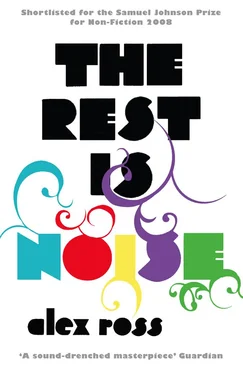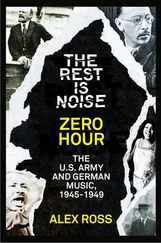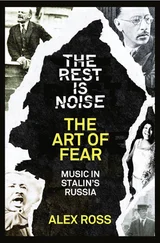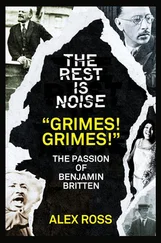Largely unable to compose, Berg filled his notebook with instructions for the proper conduct of trench warfare and bureaucratic military parlance. But, as the scholar Patricia Hall notes, the same book is dotted with sketches for a work that would put the war in a different light: an opera based on Georg Büchner’s play Woyzeck.
Büchner was a strikingly original literary talent who died in 1837 at the age of twenty-three. Woyzeck—Berg retained a misspelling from the first edition—was based on the true story of one Johann Christian Woyzeck, a soldier turned barber who had murdered his mistress in Leipzig in 1821. Despite Woyzeck’s obvious signs of mental instability, the distinguished Hofrat Dr. Clarus—Felix Mendelssohn’s doctor—declared him competent to stand trial. Büchner used transcripts of Woyzeck’s psychological examinations as source material for the play; no writer had ever given such a matter-of-fact report on a murderer’s mind. In Büchner’s telling, Woyzeck is still a soldier when the action begins, and military discipline speeds his mental deterioration. He is subject to the whims of a fussy, pedantic captain; falls prey to a sadistically experimenting doctor, who puts him on an all-pea diet, with mutton to follow; and is demoralized by the callousness of his fellow soldiers, the mockery of tradespeople, and the diseased atmosphere of his ordinary-seeming town. After a time, he can no longer tell what is real and what is fantasy.
When Berg first saw Büchner’s play, in May 1914, he immediately muttered aloud that someone had to make an opera out of it. His military experiences hardened his resolve. “There is a bit of me in [Wozzeck’s] character,” he wrote to his wife four years later, “since I have been spending these war years just as dependent on people I hate, have been in chains, sick, captive, resigned, in fact humiliated.” All too well he knew real-life versions of the Doctor and the Captain (as Büchner named them); the sketchbook hints that a certain Dr. Wernisch furnished inspiration.
Berg set Büchner’s play “raw,” cutting and arranging the text himself rather than handing it off to a librettist. This was Debussy’s procedure with Pelléas, and also Strauss’s with Salome, and, in fact, Berg used both those operas as structural models. The project moved ahead in spite of Schoenberg, who pronounced the subject matter inappropriate. Berg went so far as to conceal his labors from his former teacher, at one point leading him to believe that he was working on an ostensibly more pressing task: a biography of Arnold Schoenberg.
Freud spoke of the “return of the repressed”; in Wozzeck, tonality will not be denied. When the curtain goes up, Wozzeck is administering a morning shave to his captain. The music scrapes like a razor: one abrasive five-note string chord slides down to another, comprising ten notes in all. But the top three notes in the first chord spell Dminor; the second chord contains the notes of A-flat minor; the remaining four notes in the opening group form a diminished seventh. (Think of those paintings by Turner and Monet in which familiar forms are buried under layers of impasto paint.) The latent tonalities emerge more clearly in the following scene, where Wozzeck collects kindling with a comrade and hallucinates a world on fire. They come to the surface in the third scene, with the entrance of Marie, Wozzeck’s common-law wife.
Marie is something more than a fin-de-siècle cartoon of instinctual Woman; although she stereotypically lusts for a muscular Drum Major, she is, on the whole, an independent, fully formed character, one who balances her sexual desires with strong religious feeling and dotes lovingly on her child. Marie’s lullaby to her son is unabashedly Romantic, richly if eccentrically tonal. It begins with a familiar sound—the five-note Salome chord that Berg had already quoted in his Altenberg songs. Yet the music is also intimately related to Wozzeck’s more dissonant gamut of sounds. The main motifs for husband and wife both contain the notes of a theme that is first heard in the opening scene, when Wozzeck sings of his desperate situation—“Wir arme Leut,” or “We poor people.” This signifies that both Wozzeck and Marie are victims of a larger injustice.
If there is one malign character in Wozzeck, it is the doctor, who does everything in his power to accelerate his patient’s decline, in the belief that this “beautiful aberratio mentalis partialis” will guarantee his immortality. The Doctor dominates the fourth scene of Act I, which takes the form of a Passacaglia, or variations over a ground bass. The theme is a row of twelve notes, which serves to represent the character’s ruthless rationality, his urge to reduce humans to data. The Doctor even sings a little aria to his intellect at the end: “Oh my theory! Oh my fame!” At one point there is a quotation from Schoenberg’s Five Pieces for Orchestra. One wonders if the Doctor has a little Schoenberg in him. Berg loved to encode messages in his scores, and it may be no accident that when the doctor enters, the bass line moves from A to E-flat, or, in German lettering, A Es—Schoenberg’s initials. Wozzeck answers with the notes B-flat and A, which in German are spelled B A—Berg, Alban. (When Berg wrote this music, Schoenberg had not yet announced his twelve-tone method, which is described in Chapter 6.)
By the last scene of Act I, when the brutish Drum Major forces himself on Marie to the tune of dissonated C-major chords and the strains of “We poor people,” the method of the opera is clear. Strongly dissonant writing suggests the working of abstractions: the cruelty of authority, the relentlessness of fate, the power of economic oppression. Tonal elements represent basic emotions—a mother’s love for her child, a soldier’s lust for flesh, Wozzeck’s jealous rage. The scheme contradicts Schoenberg’s utopian notion that the new language could replace the old. Instead, Berg returns to the method of Mahler and Strauss, for whom the conflict of consonance and dissonance was the forge of the most intense expression. Consonance is all the sweeter in the moment before its annihilation. Dissonance is all the more frightening in contrast to what it destroys. Beauty and terror skirmish, fighting for Wozzeck’s hollow soul.
Berg took pride in the fact that each scene in Wozzeck is based on a historical form: Suite, Passacaglia, Rondo, and so on. Act II is a five-movement symphony, and in the opening Sonata Allegro, Wozzeck’s paranoia is developed like a classical theme. Once a level of maximum dissonance has been reached, there comes a sudden respite in the form of a C-major chord: this marks the moment that Wozzeck hands over to Marie the money he has earned for suffering through the sadistic games of the Captain and the Doctor. It is the last display of uncomplicated tenderness between the two.
In the second movement (Invention and Fugue on Three Themes), the Captain and the Doctor amuse themselves again by tormenting their charge, implanting in him the fatal idea that Marie has slept with the Drum Major. Wozzeck confronts his wife in the slow Largo movement, accompanied by the same fifteen instruments that Schoenberg used in his First Chamber Symphony (Schoenberg’s marital crisis of 1908 might be a subtext). The Scherzo of the “symphony” is set in an inn full of drunken revelers; a stage band plays a Mahlerian Ländler waltz, dissonantly distorted. Wozzeck’s humiliation reaches its height in the Rondo marziale, the last movement, when he tries unsuccessfully to find rest in a barracks full of atonally snoring soldiers. The Drum Major barges in, bragging of his conquest of Marie. Wozzeck whistles at him derisively and is beaten to a pulp.
At the beginning of Act III, Marie reads aloud from the Bible to her child, her mind swaying back and forth between the calm glow of Christian verities and the virus-like action of fear and guilt. A heart-stoppingly beautiful horn theme—an extract from a piano piece that Berg had written during his studies with Schoenberg—is almost immediately scrubbed out by twelve-note patterns and other “difficult” features. When Wozzeck enters, the note B begins droning in various sections of the orchestra, sometimes high and sometimes low. The couple walks by a pond. The moon rises, and each of them comments on the apparition. “How the moon rises red,” Marie says. “Like a bloody iron,” Wozzeck adds. Büchner’s writing here looks ahead to the Symbolist poetry of Wilde’s Salomé, and, as if on cue, trumpets, horns, and violas play a transposition of Strauss’s Salome chord, with its hint of outlaw sexuality on the brink of destruction.
Читать дальше












